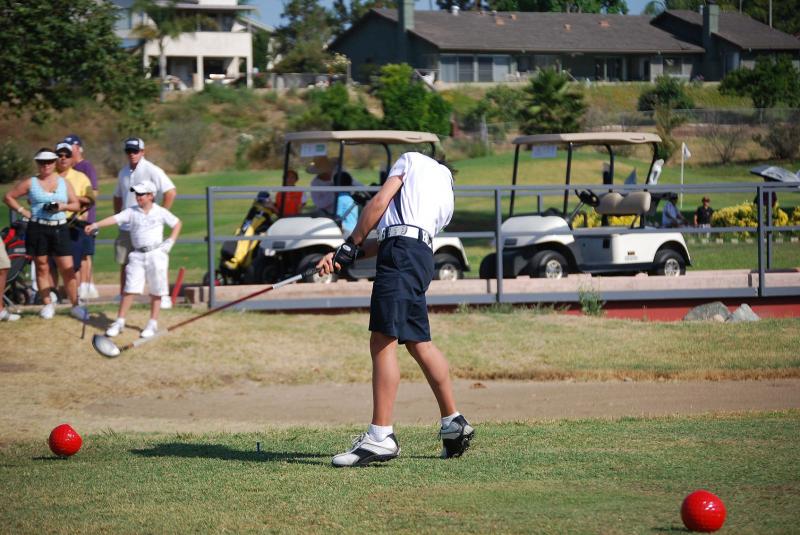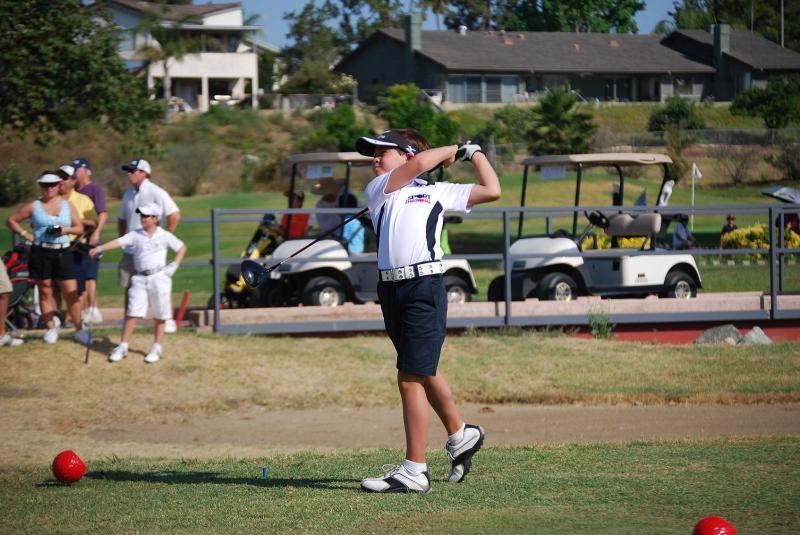"Koala" Karl Vilips
(Karl's official website managed by Paul Vilips)
Karl Vilips
Western Australia
pauls
Q: Where do you get the ideas for shafts and flexes, etc?
Question: Nice swing and great player, where do you get the ideas for shafts, flexes, etc?
Answer: That's probably the most popular question that I get. Every parent since Earl Woods has been faced with the same dilemma, as until 13-years ago, parents had no option other than to chop down their old clubs, or at best, to fit Ladies shafts to heads and cut them down from there.
About that time, a company called US Kids Golf recognised this problem and commenced making clubs that were designed for children's height and ability level. Their clubs are suitable for the overwhelming majority of young kids, as they have both half sets and full "Tour" sets available. There are also a lot of the major manufacturers who also make kids clubs, with most of them being excellent quality, but they only have half-sets available. That's fine for players starting out, but once kids outgrow those in terms of ability, they then need to either get a full set from US Kids Golf, or do as I did and make your own. Frankly though, unless your child is an absolute brute (strength-wise), the US Kids option is the better way to go, as their prices are very reasonable, and they are used by the vast majority of the best juniors.
My own son Karl's story with clubs was a little different, as in 2008 in Australia, nobody much had even heard of the US Kids Clubs, so all kids of Karl's age used half-sets. The first World Championships we went to when he was 6-years-old in 2008, he rocked up with a half set and immediately noticed that all the other kids were playing full sets of US Kids clubs. At first I didn't think it was justified to have a full set, but when kids are faced with having a shot onto a small Green which is guarded on all sides by bunkers and need to be hitting a full shot so as to get the ball to stop after it's cleared the front bunker, then that's where having the full set is justified. I remember the Par 3 8th hole at the Midland Golf Club in Pinehurst well. Every day, Karl had trouble getting the 5-iron he had to stay on the green after it cleared the front bunker, yet his 7-iron couldn't get over the bunker. If he'd had a 6-iron, he'd have been able to have much more chance of hitting and staying on that green each round. The 3-shots which that hole cost him over the 3 days wasn't the difference between coming 7th and Winning, as his putting was very poor during those championships anyway, but having spent all that money on getting to the Worlds, it's worthwhile spending the extra few hundred and getting the full set.
US Kids clubs weren't available in Australia, and oddly, they didn't have sets at the championships to purchase and take on-the-spot. The postage to Australia was over $100, so I opted to make Karl a custom set when we returned to Australia.
I used heads which had a wide sole, low COG (Center of gravity) for high ball flight, and which were forgiving. The Taylormade Burner Plus heads fitted those requirements perfectly, so I got a set on "special" and removed the steel shafts, replacing those with a set of "lite" Ladies flex shafts made by Roger Maltby (which are actually manufactured by Graffalloy) which I got online from Golfworks. They only cost around $12 each. I then fitted Golf Pride "Junior" grips to fit the small hands of a 7-year-old.
Karl went on to win the next US Kids Worlds he played in. When he grew taller every 6-9 months, rather than buying all new shafts, I simply used one new one in the longest iron, then moved each shaft down a club. In this way, although not being a lot of money, it saved me buying new shafts for each club.
Nowadays at 10-years-of age he still uses Ladies flex shafts in his irons, but they are a firmer Ladies flex. Most of Karl's club now are a Mizuno "game improvemnet" club called the JPX-800 Pro, a forged iron set. The advantage of a Forged club is that they can be fitted better to the player at this age, as most kids have problems where the "heel" of their clubs hit the ground first, rather than the entire club making contact with the grass. This causes the club to kick left. By using a forged iron, the "Lie angle" of the club can be flattened out more than a typical "Cast" iron, enabling more even contact by the club with the grass. However, having said that, the Lie Angle of clubs varies between both models and manufacturers.
Some of the other clubheads which would suit a young player include the;
- Mizuno JPX 800HD & JPX 800
- Taylormade Burner & Burner Plus
- Callaway Razor series
There are many other clubs which could also be suitable, but regardless of what brand you choose, the key requirements remain as;
- Wide sole so the club doesn't "dig in" at impact.
- Low COG for high ball flight
- Cavity back for large sweet-spot
I hope this helps.


Copyright 2019 Karl Vilips. All rights reserved.
Karl Vilips
Western Australia
pauls


